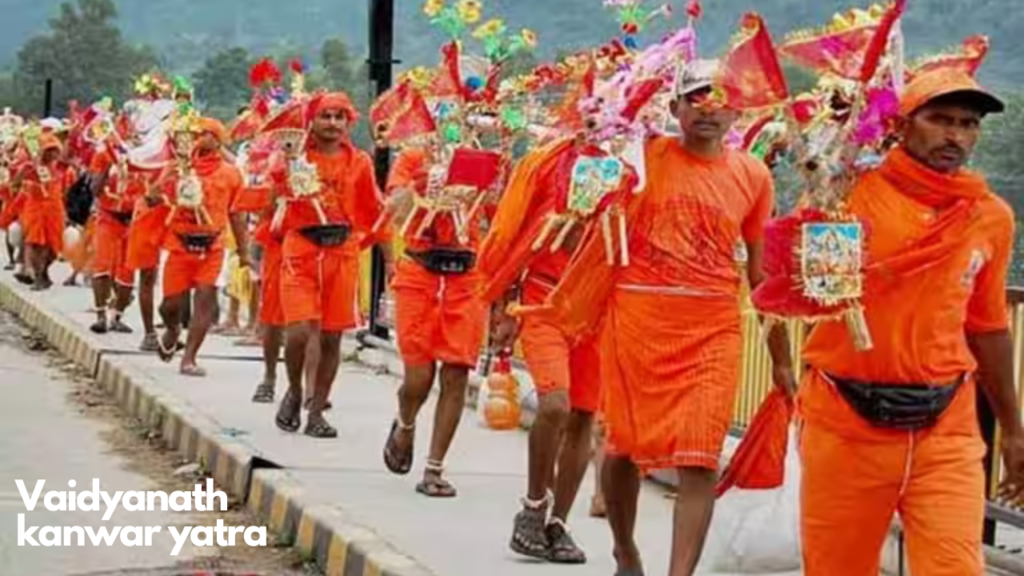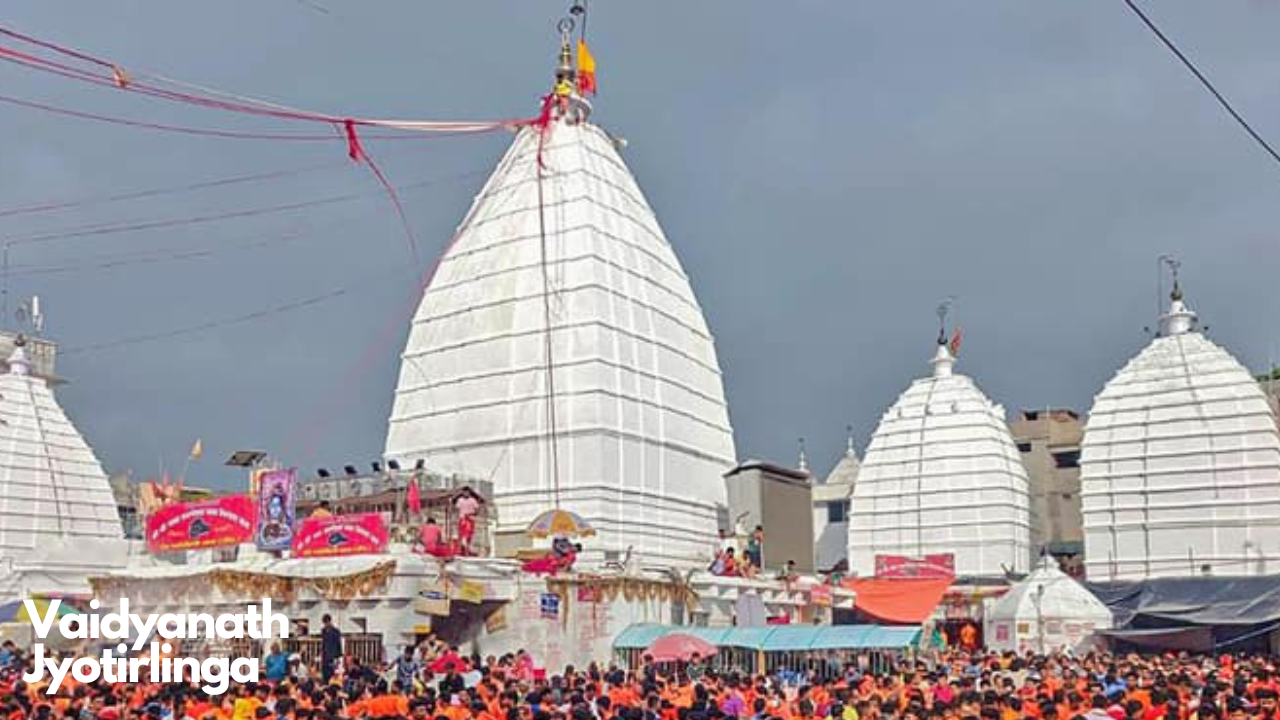Vaidyanath Jyotirlinga hold a special place, each embodying a unique manifestation of Lord Shiva’s divine energy. Among these, Vaidyanath Jyotirlinga stands as a beacon of healing and rejuvenation, revered by devotees seeking solace and wellness. Situated in the town of Deoghar in the Indian state of Jharkhand, Vaidyanath Jyotirlinga is not merely a religious site but a sanctum of spiritual and physical well-being.
Vaidyanath jyotirlinga story
The temple housing Vaidyanatha Jyotirlinga is a testament to architectural grandeur and spiritual aesthetics. Built in the Nagara style, the structure reflects the rich heritage of Hindu temple architecture. The sanctum sanctorum, adorned with intricate carvings and sculptures, creates an atmosphere of divine serenity. Pilgrims and art enthusiasts alike marvel at the detailed craftsmanship that adorns the walls, telling stories from Hindu mythology.
The Maa Parvati temple is tied up with the main temple, with huge red sacred threads that are unique and worthy of reverence, showing the unity of Shiva and Shakti. According to the stories written and mentioned in the Shiva Purana, the holy Vaidyanath temple resembles the unity of souls and thus fits marriage for Hindus.
Parli Vaidyanath jyotirlinga
The Jyotirlinga is enshrined in the central place, radiating a powerful aura. Devotees believe that the divine energy emanating from the Jyotirlinga has the power to heal physical and mental afflictions. The temple complex also houses various smaller shrines dedicated to other deities, creating a holistic spiritual environment.
Millions of pilgrims visit this shrine every year. The Vaidhyanath Temple is famous for the mela of Shraavana between July and August. About 8 to 10 million devotees visit the place from various parts of India and offer the holy water of the Ganges to the deity collected from Ajgaibinath, Sultanganj, which is approximately 108 km from Deoghar and Vaidyanath. The water is also brought by the Kanvarias, who carry the water in Kavadi and walk all the distance, barefoot. You will notice large crowds walking all the way carrying water.

An unbroken line of people in saffron-dyed clothes stretches over the full 108 km for the particular month. The pilgrims are called Dak Bam and they do not stop even once in their journey from Ajgaibinath Temple located at Sultanganj, Bhagalpur district to Vaidyanath. Pilgrims and devotees to the temple later visit the Basukinath temple along with the main temple of Baba Baidyanath, there are also 21 other temples.
Some shrines you will find here are Parvati, Ganesha, Brahma, Kalabhairav, Hanuman, Saraswati, Surya, Ram-Lakshman-Sita, Ganga, Kali, Annapurna, and Lakshmi-Narayan. The Maa Parvati temple is tied to the Shiva temple with a long red sacred thread.
The main temple has a pyramidal tower with three gold vessels set concisely. These were gifted by the Maharaja of Giddhaur who was Raja Puran Singh. There are also five knives in a trident shape as well as a lotus jewel with eight petals which is Known as Chandrakanta Mani. There is a vast Nandi, Lord Shiva’s mount, in front of the Lord.
Vaidyanath Jyotirlinga stands as a beacon of hope and healing in the spiritual landscape of India. Its rich history, architectural splendor, and the divine energy it exudes make it a destination for both religious pilgrims and seekers of holistic well-being. Beyond the physical structure, the temple embodies a profound connection between the mortal and the divine, offering a sanctuary where prayers are answered, and hearts find solace. In the radiant abode of Vaidyanatha Jyotirlinga, the pursuit of spiritual and physical healing converges, creating an enduring legacy of faith and devotion.
Vaidyanath jyotirlinga history
Ravana, one of Lord Shiva’s greatest devotees, requested him to make Lanka his home. The Lord could not permit that but said that the Shiva Linga would be as good as his presence. He placed the condition that while transporting the linga, Ravana must not put it down anywhere, and If he did, the place where he put it down would be the site of the linga.
As Ravana was taking it with him to Lanka, the gods feared the consequences of the linga at Ravana’s kingdom and requested Lord Varuna, lord of the waters, to break his journey then Varuna entered Ravana’s stomach, making the demon king want to relieve himself. He descended to the ground and handed the linga to a Brahmin named Baiju and asked him to hold it.
As soon as Ravana went to relieve himself, Baiju placed the linga on the ground and disappeared. When Ravana returned, he realized that he had been Cheated. The linga was fixed to the ground. He tried with all his might to remove it. However, he could not. So, he paid respect to it right there. This place is believed to be Deoghar.
The Vaidhyanath temple doubles as a Shakti Peetha as well. When Lord Shiva’s first wife, Sati immolated herself after her father Daksha’s yagna, the grief-stricken Lord, rambled the world with her body then Lord Vishnu cut it up into 52 parts, out of which one part fell here and it is said that her heart fell at Deoghar – making it a Shakti Peetha.
Facts about Vaidhyanath Temple
Vaidyanath Jyotirlinga is also known as Baidyanath Dham locally. Given how old the jyotirlingas and associated temples are, there is some variation in beliefs about the temple’s locations. Three different sites claim to house the real Jyotirlinga – Vaidyanath temple at Deoghar, Jharkhand, and Vaijnath temple at Parli, Maharashtra, and Bajinath temple in Bajinath, Himachal Pradesh.
Devotees are allowed to do Abhishek themselves on the jyotirlinga.
Shravan Mela is one of the major festivals of the temple which takes place here every July-August.
While you can visit this spiritual place at any time in the year, it would be best to visit it during the winter months – between October and March. Visiting this ancient and divine destination during Mahashivratri would be the ultimate treat for any devotee and pilgrim.
vaidyanath jyotirlinga images
vaidyanath jyotirlinga location
how to reach vaidyanath jyotirlinga
vaidyanath jyotirlinga nearest railway station
vaidyanath jyotirlinga nearest airport
varanasi to vaidyanath jyotirlinga train
Vaidhyanath Temple Darshan timing
The temple opens for Darshan from 4:00 AM to 9:00 PM the temple remains closed from 3:00 PM to 6:00 PM. The pooja timings of the Vaidyanath Temple might Change during festivals and special days.
Puja Timing For Vaidyanath Jyoirtilnga
- Vishesh Pooja at 4:00AM
- Thomala seva at 4:15AM
- Kakad Arti at 4:30AM
- Bhajan at 5:00AM
- Snan at 5:05AM
- Arti at 5:30AM
- Mahaarti at 7:30AM
Frequently Asked Questions
Vaidyanath Jyotirlinga is in Which State?
It is located in Deoghar, in the Santhal Parganas division of the Indian state of Jharkhand.
Where is Vaidyanath Jyotirlinga?
Vaidyanath Jyotirlinga is located in Deoghar, which is a city in the Indian state of Jharkhand.
How to reach Vaidyanath Jyotirlinga?
By air:- The nearest airport to Deoghar is the Deoghar Airport (IATA: VDS), which is well-connected to major cities.
By Train:- The Deoghar Railway Station is well-connected to major cities in India. You can check train schedules and book tickets to reach Deoghar by train. The railway station is at a convenient distance from the Vaidyanath Jyotirlinga temple.
By Road From Kolkata:- Deoghar is approximately 350 kilometers from Kolkata. You can take a bus or hire a taxi from Kolkata to reach Deoghar.
From Patna:-Deoghar is approximately 281 kilometers from Patna. You can take a bus or hire a taxi from Patna to reach Deoghar.
From Ranchi:- Deoghar is approximately 260 kilometers from Ranchi. You can take a bus or hire a taxi from Ranchi to reach Deoghar.
1.

